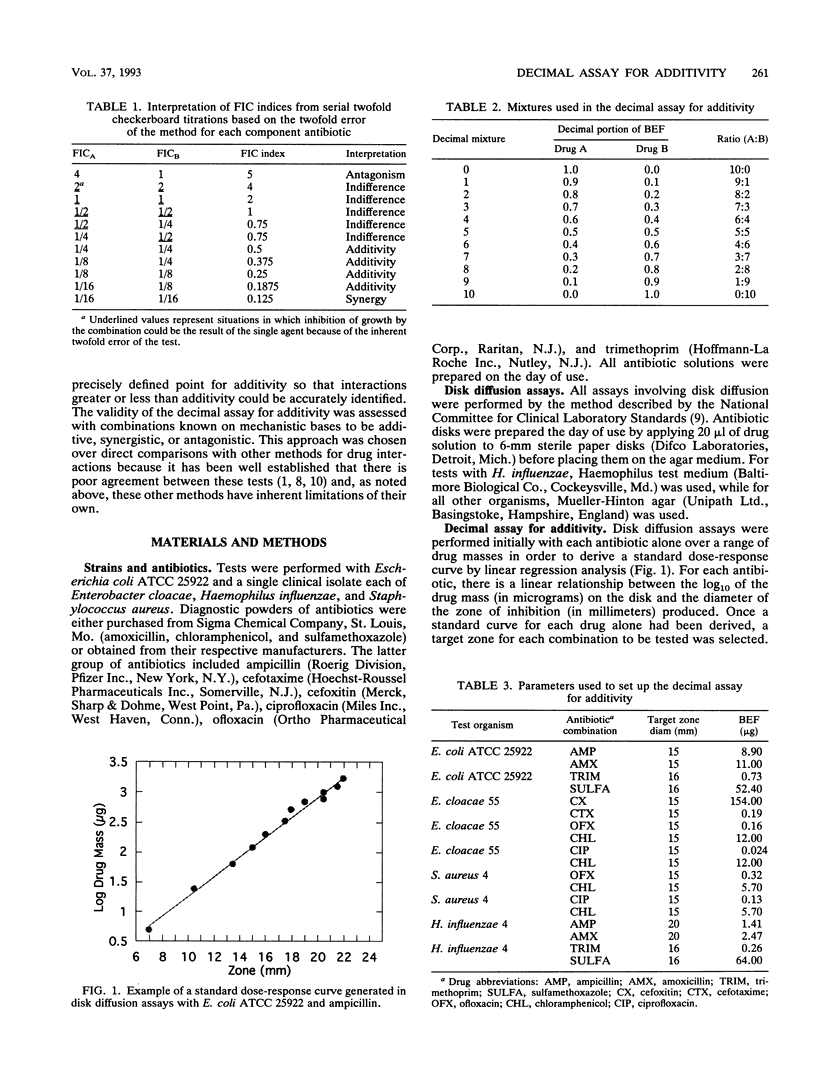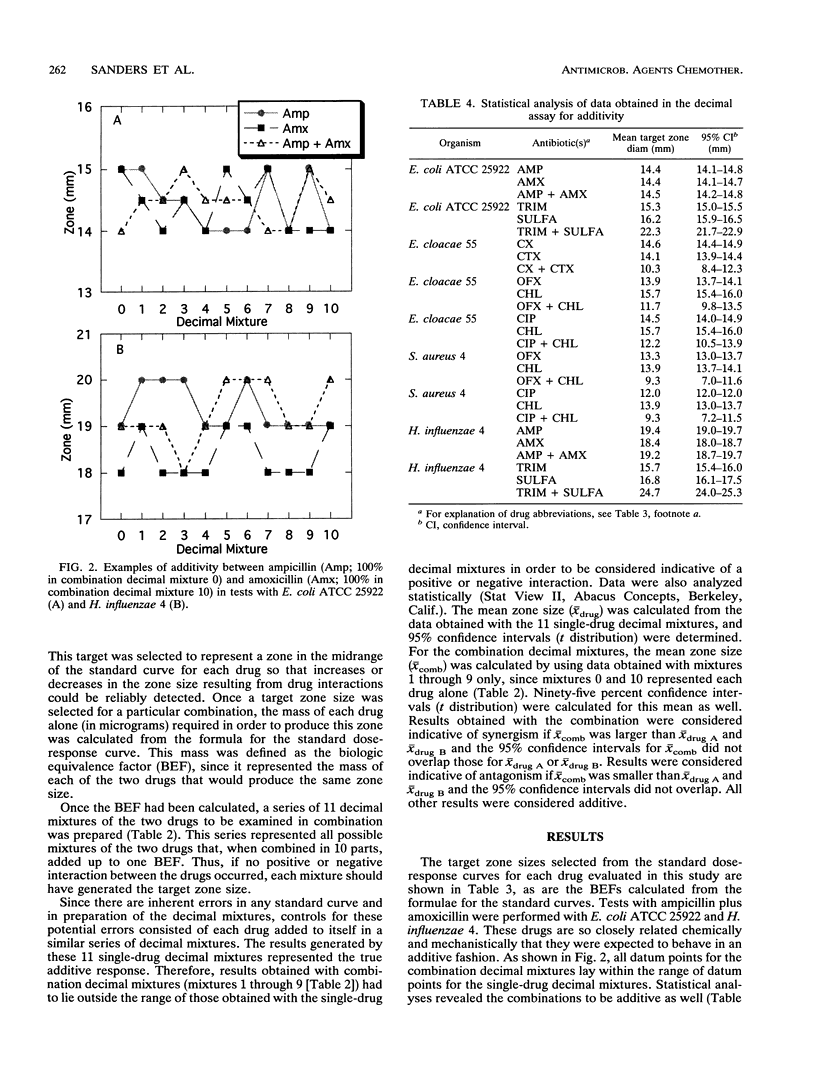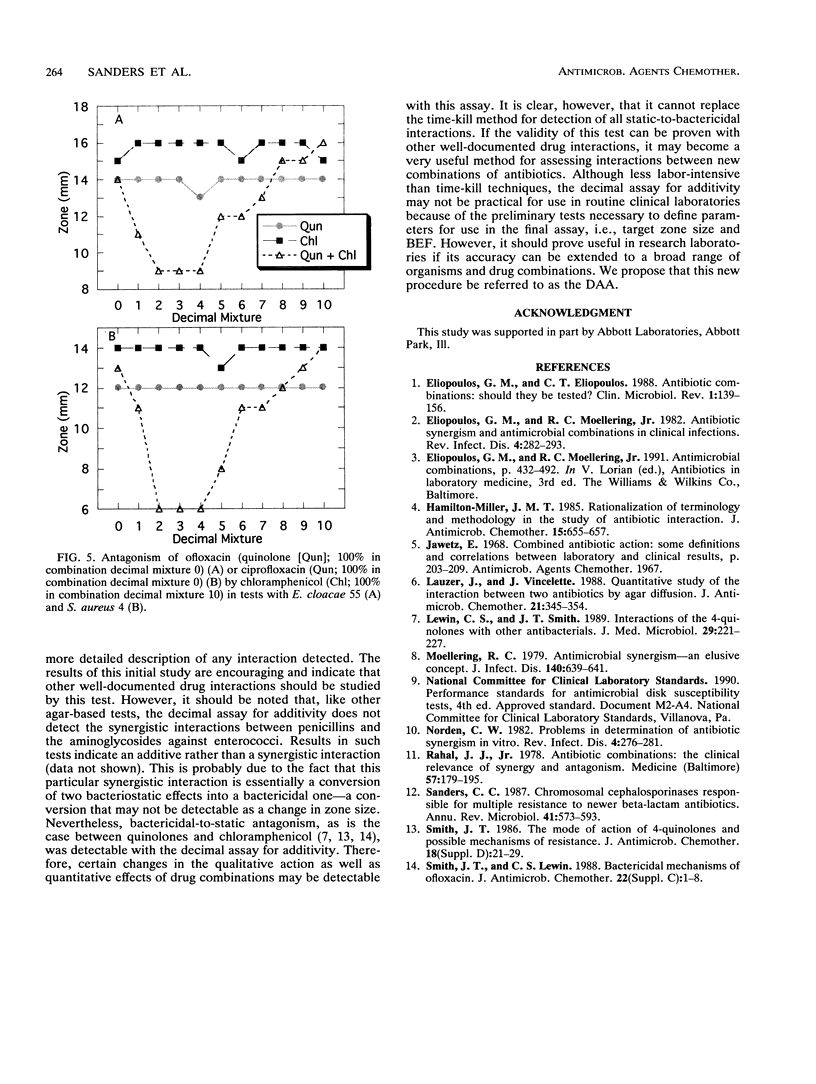Abstract
Although there are many in vitro tests for drug interactions, few possess a linear, predictable dose-dependent end point or have a precise definition for additivity. Therefore, a new test with both of these features, the decimal assay for additivity, was developed. This test is based on a disk diffusion assay and the strict linear relationship between drug mass and size of the inhibition zone. When the decimal assay for additivity was applied to combinations known on a mechanistic basis to be additive, synergistic, or antagonistic, results of the new test always reflected the expected drug interaction. For example, synergy between trimethoprim and sulfamethoxazole was detected in tests with Escherichia coli and Haemophilus influenzae, as was antagonism between cefoxitin and cefotaxime in tests with Enterobacter cloacae. Quinolones plus chloramphenicol appeared to be antagonistic. In addition to correctly identifying the drug interaction, the decimal assay for additivity identified the drug ratio producing the maximal drug interaction. These results suggest that the decimal assay for additivity should prove very useful in future studies of drug interactions.
Full text
PDF




Selected References
These references are in PubMed. This may not be the complete list of references from this article.
- Eliopoulos G. M., Eliopoulos C. T. Antibiotic combinations: should they be tested? Clin Microbiol Rev. 1988 Apr;1(2):139–156. doi: 10.1128/cmr.1.2.139. [DOI] [PMC free article] [PubMed] [Google Scholar]
- Eliopoulos G. M., Moellering R. C., Jr Antibiotic synergism and antimicrobial combinations in clinical infections. Rev Infect Dis. 1982 Mar-Apr;4(2):282–293. doi: 10.1093/clinids/4.2.282. [DOI] [PubMed] [Google Scholar]
- Hamilton-Miller J. M. Rationalization of terminology and methodology in the study of antibiotic interaction. J Antimicrob Chemother. 1985 Jun;15(6):655–658. doi: 10.1093/jac/15.6.655. [DOI] [PubMed] [Google Scholar]
- Lauzer J., Vincelette J. Quantitative study of the interaction between two antibiotics by agar diffusion. J Antimicrob Chemother. 1988 Mar;21(3):345–354. doi: 10.1093/jac/21.3.345. [DOI] [PubMed] [Google Scholar]
- Lewin C. S., Smith J. T. Bactericidal mechanisms of ofloxacin. J Antimicrob Chemother. 1988 Sep;22 (Suppl 100):1–8. doi: 10.1093/jac/22.supplement_c.1. [DOI] [PubMed] [Google Scholar]
- Lewin C. S., Smith J. T. Interactions of the 4-quinolones with other antibacterials. J Med Microbiol. 1989 Jul;29(3):221–227. doi: 10.1099/00222615-29-3-221. [DOI] [PubMed] [Google Scholar]
- Moellering R. C., Jr Antimicrobial synergism--an elusive concept. J Infect Dis. 1979 Oct;140(4):639–641. doi: 10.1093/infdis/140.4.639. [DOI] [PubMed] [Google Scholar]
- Norden C. W. Problems in determination of antibiotic synergism in vitro. Rev Infect Dis. 1982 Mar-Apr;4(2):276–281. doi: 10.1093/clinids/4.2.276. [DOI] [PubMed] [Google Scholar]
- Rahal J. J., Jr Antibiotic combinations: the clinical relevance of synergy and antagonism. Medicine (Baltimore) 1978 Mar;57(2):179–195. [PubMed] [Google Scholar]
- Sanders C. C. Chromosomal cephalosporinases responsible for multiple resistance to newer beta-lactam antibiotics. Annu Rev Microbiol. 1987;41:573–593. doi: 10.1146/annurev.mi.41.100187.003041. [DOI] [PubMed] [Google Scholar]
- Smith J. T. The mode of action of 4-quinolones and possible mechanisms of resistance. J Antimicrob Chemother. 1986 Nov;18 (Suppl 500):21–29. doi: 10.1093/jac/18.supplement_d.21. [DOI] [PubMed] [Google Scholar]


